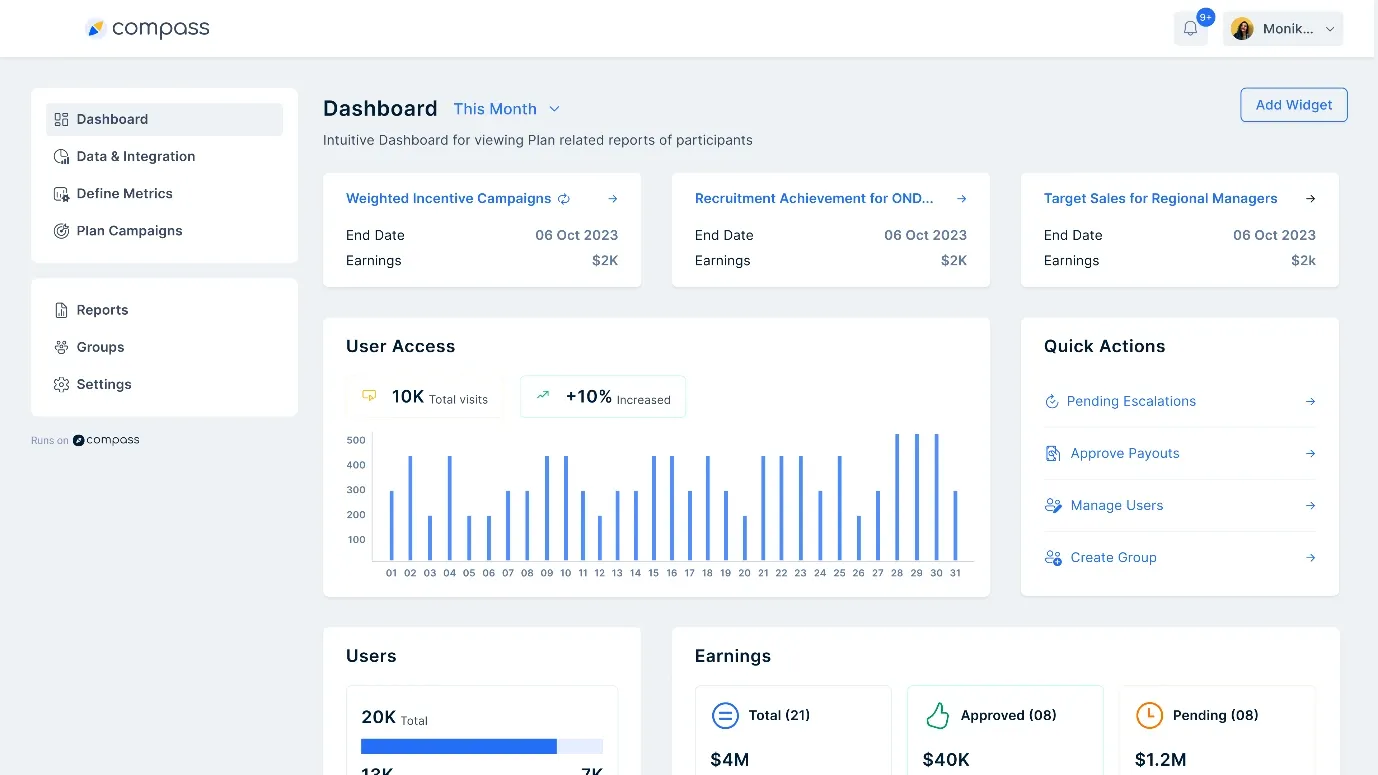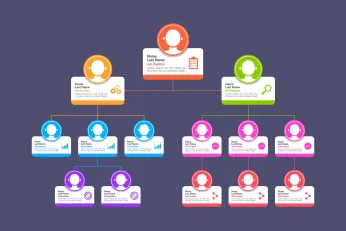Le guide du leader des ventes pour maîtriser le tableau de bord des ventes : Construire, suivre et stimuler la performance des ventes en 3 étapes
Le tableau de bord d'un vendeur est un document formel qui permet de suivre les performances d'un vendeur par rapport à des indicateurs clés qui comprennent à la fois les niveaux d'activité et les résultats des ventes.
Sur cette page
Imaginez que vous êtes directeur commercial et que vous essayez de suivre les performances de votre équipe. Vous avez plusieurs représentants, différents objectifs et une infinité de points de données. Comment savoir qui excelle et qui a besoin de soutien ? C'est là que le tableau de bord des ventes devient votre arme secrète.
Un tableau de bord de l'équipe de vente bien structuré vous aide à mesurer le succès, à responsabiliser les représentants et à affiner votre processus de vente. Il met en évidence les personnes les plus performantes, encourage une concurrence saine et permet à votre équipe de rester sur la bonne voie.
Dans ce guide, nous vous expliquons tout ce que vous devez savoir sur les tableaux de bord des ventes - ce qu'ils sont, pourquoi ils sont importants et comment en créer un. De plus, nous partagerons avec vous des conseils et des exemples de cartes de pointage pour les représentants des ventes afin de vous aider à démarrer.
Qu'est-ce qu'un tableau de bord pour les vendeurs ?
Un tableau de bord des vendeurs est un outil, c'est-à-dire un système formel qui permet à la force de vente de mesurer et de suivre les performances des représentants au sein d'une organisation.
Il s'agit d'un moyen structuré d'évaluer les mesures et les objectifs clés qui sont essentiels à la réussite de l'équipe de vente. Avec un tableau de bord, un vendeur peut vérifier d'un seul coup d'œil :
- Le montant total des revenus générés par le vendeur est souvent mesuré sur une base mensuelle ou trimestrielle.
- Le pourcentage du quota ou de l'objectif de vente que le vendeur a atteint.
- Le nombre de nouveaux clients ou comptes que le vendeur a réussi à intégrer.
- Pourcentage de clients existants que le vendeur a conservés au cours d'une période donnée.
- Valeur monétaire moyenne des affaires ou des ventes conclues par le vendeur.
Un tableau de bord permet également au vendeur de suivre ses performances en comprenant ses forces et ses faiblesses. Les aspects liés aux performances qu'un commercial peut suivre sont les suivants :
- Nombre de pistes ou d'opportunités qualifiées générées par diverses activités de prospection.
- Le pourcentage d'opportunités de vente que le vendeur a réussi à convertir en affaires conclues.
- Niveau de satisfaction des clients
- La possibilité de faire de la vente incitative et de la vente croisée.
Ces informations peuvent ensuite être utilisées pour identifier les domaines à améliorer, fournir un coaching et une formation ciblés et, en fin de compte, améliorer les performances commerciales et les résultats de l'entreprise. Référence de Bain & Company.
Le client de Bain & Companyun géant mondial de l'informatique a connu une croissance rapide de son chiffre d'affaires. Cependant, ses coûts de vente et de marketing augmentaient encore plus vite que ses ventes. Ils ont donc cherché à savoir comment cet argent était dépensé et ont examiné à la fois l'équipe de vente elle-même et sa carte de pointage pour comprendre les domaines à améliorer et les processus qui la préparent aux interactions avec les clients.
L'un des problèmes était que les vendeurs avaient du mal à obtenir la formation et les informations nécessaires sur les nouveaux produits lorsqu'ils étaient lancés. Ce manque de connaissances a eu un impact sur leur capacité à vendre efficacement ces produits. Les vendeurs passaient ainsi moins de 25 % de leur temps à interagir directement avec les clients. Par conséquent, la productivité globale des ventes s'en est trouvée considérablement réduite.
Bain & Co. a donc analysé et identifié les pratiques de développement des ventes les plus efficaces qui répondaient directement aux défis spécifiques de son client. Pour ce faire, il a fallu examiner les pratiques internes, y compris le maintien de leur progression, ainsi que leurs lacunes.
Pour obtenir une augmentation rapide de la productivité, Bain & Company conseille à son client d'avoir une culture plus disciplinée basée sur la formation. Le client a investi dans des programmes de formation complets pour les commerciaux qui avaient un potentiel d'amélioration.
Il a également conseillé de réorganiser son modèle de vente, en fonction des ventes et des incitations liées aux produits de nouvelle génération. Ainsi, au lieu de s'appuyer sur des centaines de portails dispersés, il convient de créer un espace de travail en ligne unique et centralisé permettant aux vendeurs d'accéder efficacement à toutes les informations nécessaires.
Ils ont également indiqué que leurs clients devaient aller au-delà des supports de vente statiques. Ils doivent donc mettre en œuvre des outils de vente interactifs qui encouragent le retour d'information de la part des vendeurs et des clients afin d'améliorer l'efficacité de la communication et des présentations.
Résultat :
- Le temps consacré par le client à la vente a augmenté de 33 % et le délai de réalisation des recettes s'est amélioré.
- Ses coûts globaux ont diminué de 10 % et il a économisé plus de 25 millions de dollars en dépenses non liées à la vente et au marketing.
- Les changements apportés à la stratégie de partenariat ont permis de réaliser plus de 20 millions de dollars d'économies réelles et de générer un potentiel de 250 millions de dollars de réservations supplémentaires.
Cette étude de cas démontre la valeur de l'analyse des données de performance des représentants commerciaux individuels dans toutes les équipes. Ce faisant, Bain & Company a été en mesure de développer une stratégie qui s'est avérée très bénéfique.
Cette stratégie a non seulement permis d'augmenter le chiffre d'affaires du client de 250 millions de dollars en réservations supplémentaires, mais elle a également donné aux représentants commerciaux la possibilité d'améliorer leurs compétences grâce à une formation ciblée.
Différence entre carte de score des ventes et tableau de bord des ventes
Les tableaux de bord des ventes sont des outils précieux pour gérer les performances commerciales, mais ils ont des objectifs différents. Atableau de bord commercialest une représentation visuelle des principaux indicateurs de vente, qui donne un aperçu en temps réel de l'activité et des performances. Il s'agit en quelque sorte d'un hub central qui affiche les points de données importants, permettant ainsi un suivi rapide des progrès réalisés.
Alors qu'un tableau de bord des ventes va au-delà de la simple présentation de données, il permet de suivre les progrès accomplis dans la réalisation d'objectifs spécifiques. Il permet de suivre les progrès accomplis dans la réalisation de buts et d'objectifs spécifiques. Il s'agit d'un bulletin de notes qui compare les performances actuelles aux objectifs fixés. Il permet d'évaluer dans quelle mesure l'équipe de vente est sur la bonne voie pour atteindre ses objectifs.

Mais le tableau de bord Compass a une toute autre fonction. Le tableau de bord est utilisé à des fins de gamification pour aider les entreprises à transformer leurs activités de vente en une aventure engageante et génératrice de revenus. Il affiche des classements en temps réel et des cartes de score détaillées pour les commerciaux.

En outre, le tableau de bord permet aux commerciaux de comparer leurs performances à celles de leurs pairs, ce qui contribue à accroître la productivité et la motivation des vendeurs.
Vous pouvez obtenir une vue en temps réel de leurs performances, de leurs commissions et de la progression de leurs objectifs.stratégies de commissionde commissions.
Exemples de cartes de pointage pour les vendeurs
Vous voulez savoir à quoi ressemble un bon tableau de bord des ventes ? En voyant des exemples concrets, il est plus facile de comprendre leur fonctionnement. Examinons quelques exemples de cartes de pointage des ventes qui permettent de suivre les performances, de stimuler la motivation et d'obtenir des résultats.
1. Carte de pointage du représentant commercial individuel
Cette carte de pointage des représentants commerciaux se concentre sur les performances mensuelles d'un individu. Créée par Slide Team, elle permet de suivre les indicateurs clés de la carte de pointage des ventes, tels que :
- Le nombre moyen d'appels par heure
- Temps de réponse aux pistes
- Critères de performance et objectifs
Grâce à ce tableau de bord, un vendeur peut voir ce qui fonctionne et ce qu'il doit améliorer. Cela l'aide à rester sur la bonne voie et à prendre de meilleures décisions en matière de vente.
2. Tableau de bord de l'équipe de vente SaaS
Pour une vision plus large, un tableau de bord de l'équipe de vente permet de comparer les performances de plusieurs représentants. Ce tableau de bord de l'activation des ventes met en évidence des indicateurs clés tels que :
- Le nombre d'appels de démonstration effectués
- Acquisition de nouveaux clients (logos gagnés)
Les responsables des ventes peuvent utiliser cette fiche de performance des commerciaux pour mesurer la productivité, encourager une compétition amicale et fixer des objectifs clairs.
L'utilisation d'un tableau de bord bien structuré pour les commerciaux permet de rendre les performances transparentes et mesurables.
Maintenant que nous avons découvert les deux types d'utilisation des cartes de pointage des commerciaux, apprenons à les construire.
Comment élaborer un tableau de bord des ventes ?
Suivez ce guide pour élaborer un tableau de bord des ventes adapté à votre équipe.
Étape 1 : Choisir les bons indicateurs
Un bon tableau de bord des ventes commence par les bons indicateurs. Ceux-ci doivent être significatifs, exploitables et directement liés à la réussite. Évitez de suivre les tâches administratives telles que la mise à jour d'un CRM. Concentrez-vous plutôt sur les activités qui génèrent des résultats, telles que
- Génération de pistes qualifiées
- Appels sortants effectués
- Envoi des propositions
- Réunions de vente programmées
- Contrats gagnés contre contrats perdus
Avant de finaliser les mesures, vérifiez vos indicateurs clés de performance actuels en matière de vente. Identifiez les activités qui augmentent votre taux de réussite. Par exemple, si les réunions en face à face améliorent le taux de conclusion de 30 %, incluez-les dans votre tableau de bord des ventes.
Posez-vous la question :
- Les représentants atteignent-ils leurs objectifs ?
- Notre équipe améliore-t-elle les performances ?
- Comment les personnes les plus performantes parviennent-elles à conclure des ventes ?
- Générons-nous et qualifions-nous suffisamment de prospects ?
Choisissez trois indicateurs avancés (comme les appels ou les réunions) et un indicateur retardé (comme les affaires conclues) afin d'obtenir un tableau de bord équilibré.
Étape 2 : Fixer des objectifs clairs
Une fois les indicateurs sélectionnés, fixez des objectifs réalistes. Utilisez les données existantes pour travailler à rebours des objectifs de revenus. Par exemple :
- Objectif : 10 millions de dollars par trimestre
- Montant moyen des transactions : 1 million de dollars
- Offres nécessaires : 10
- Si 25 % des propositions se traduisent par des ventes, 40 propositions sont nécessaires.
- Si 1 prospect sur 5 atteint le stade de la proposition, 200 prospects sont nécessaires.
- Si 10 appels aboutissent à une réunion, 2 000 appels sont nécessaires.
Répartissez maintenant ces objectifs au sein de l'équipe. Si dix représentants se partagent la charge de travail, chacun doit passer 200 appels par trimestre. Les responsables doivent suivre ces chiffres sur le tableau de bord de l'équipe de vente.
Étape 3 : Attribuer des poids aux mesures
Toutes les activités n'ont pas la même importance. Donnez la priorité aux actions qui ont un impact direct sur les recettes. Attribuez des pondérations en fonction de l'impact :
- Affaires arrivant au stade de la proposition = poids le plus élevé
- Démonstrations (débouchant sur des propositions) = poids moyen
- Appels sortants (conduisant à des démonstrations) = poids le plus faible
Cette approche garantit que les représentants se concentrent sur des tâches à forte valeur ajoutée plutôt que de se contenter d'atteindre des chiffres d'activité.
Prenons l'exemple de cette plateforme de boissons à base de chai.
Prenons l'exemple de l'intégration de Compass par la plus grande plateforme de boissons Chai au monde. Cette intégration a permis de rationaliser l'analyse des performances de l'équipe de vente.
Cette célèbreplateforme de boissonsest la première plateforme mondiale axée sur les boissons Chai. Elle opère sur différents canaux et touche des millions de clients chaque jour. Ces canaux comprennent les magasins de détail, les cuisines de livraison et les partenariats avec les entreprises et les institutions.
Cependant, l'entreprise a été confrontée à des difficultés car ses programmes d'incitation étaient complexes et reposaient sur un suivi manuel des boissons. Différentes incitations étaient offertes à l'équipe de vente pour l'installation des machines et aux distributeurs pour le déploiement des machines et la consommation des produits.
Pour compliquer encore les choses, des facteurs tels que les dépôts de garantie, les frais mensuels, les fermetures de magasins et les contrats affectaient également les paiements finaux.
Malheureusement, ni les responsables ni les vendeurs ne disposaient d'une visibilité claire sur les performances commerciales. Le calcul des primes manquait de transparence et les paiements étaient retardés en raison d'un suivi manuel, de l'implication de plusieurs équipes et de l'absence de données en temps réel. Pour résoudre ces problèmes, l'entreprise a cherché une solution conviviale de gestion des performances commerciales.
Elle a intégré Compass:
Pour améliorer son système de gestion des ventes, cette entreprise de boissons a intégré Compass. La plateforme dédiée aux boissons disposait d'une configuration simplifiée pour le calcul des commissions et la gestion des performances.
Elle a également gagné en transparence sur les performances de l'équipe de vente grâce au tableau de bord des vendeurs de Compass et a fourni aux utilisateurs finaux une visibilité claire sur leurs commissions de vente. En conséquence,
- Cette entreprise de boissons à base de chai a réussi à motiver le BD et les distributeurs à être plus performants grâce à la transparence des commissions de vente.
- Les commissions versées aux BD et aux distributeurs ont augmenté de 200 %.
- Les recettes de consommation ont augmenté en moyenne de 4 % chaque trimestre.
- Le nombre de machines déployées a augmenté de 40 % en l'espace de six mois.
- Le nombre de personnes pouvant prétendre à des primes de commission a augmenté de 115 % au cours des six derniers mois.
Meilleures pratiques basées sur les organisations leaders du secteur pour créer des tableaux de bord pour les vendeurs :
Les études de cas susmentionnées de Bain & Company et de la principale plateforme de boissons à base de chai mettent en évidence plusieurs bonnes pratiques de gestion des performances de vente grâce à l'intégration de la technologie. Pour vous assurer que vous mettez en œuvre une carte de pointage gagnante, maintenez :
- Un programme d'incitation rationalisé :À l'instar de la plateforme de boissons, simplifiez votre structure d'incitation jusqu'alors complexe. L'entreprise de boissons à base de chai a intégré Compass , ce qui a permis aux responsables et aux vendeurs de comprendre plus facilement le calcul des commissions.
- Amélioration de la visibilité des ventes :Toujours avoir une visibilité totale des performances de chaque représentant commercial. La carte de pointage des vendeurs de Compass a fourni à l'industrie des boissons des données en temps réel sur les performances. Les responsables et les vendeurs ont ainsi une vision claire de l'activité commerciale et des progrès réalisés par rapport aux objectifs fixés.
- Transparence et efficacité :Éliminer le suivi manuel et les retards dans les paiements afin d'accroître la transparence du processus d'incitation.
- Motivation accrue des représentants commerciaux: Une meilleure visibilité des commissions et des paiements en temps voulu sont de nature à motiver l'équipe de vente à être plus performante. Compass a offert la simplicité avec des capacités de suivi et Bain & Company a conseillé à ses clients de mettre en place une méthode de formation ciblée pour augmenter la participation et la motivation.
- Prendre des décisions fondées sur des données :Les systèmes de gestion de la relation client fournissent des informations précieuses pour guider la prise de décision stratégique. Veillez toujours à ce que votre équipe ait accès aux fonctions d'analyse. Les commerciaux peuvent obtenir des informations précieuses pour guider la prise de décisions stratégiques. Un tableau de bord des vendeurs peut aider les représentants à surveiller les performances de l'employé et de l'équipe, ainsi qu'à prévoir la rentabilité.
- Mesurer la performance, le droit :L'un des points communs entre toutes les entreprises, à savoir la plateforme de boissons et Bain & Company, est qu'elles souhaitaient toutes mesurer les performances de leurs vendeurs. Les indicateurs clés de performance spécifiques aux représentants et aux étapes du projet aident les organisations à suivre les performances des employés et des équipes. Cette approche fondée sur les données permet une amélioration continue et une correction de trajectoire si nécessaire.
Le respect des meilleures pratiques recommandées vous aidera à garantir l'efficacité et la précision de votre carte de pointage des vendeurs.
Maximisez la productivité de votre équipe de vente grâce à la carte de pointage des représentants commerciaux
L'intégration d'un tableau de bord des vendeurs vous permet d'obtenir une image claire des résultats de votre équipe par rapport aux buts et objectifs fixés. Cela vous permet non seulement d'identifier les points forts et les points faibles, mais aussi de prendre des décisions éclairées sur les stratégies de vente en analysant les données du tableau de bord.
Nous recommandons Compass. Compass aide les équipes de vente à suivre les performances individuelles et collectives grâce à des tableaux de bord détaillés. Grâce à cette solution, vous pouvez :
- Obtenez une visibilité en temps réel sur les performances des commerciaux.
- Contrôler les résultats et motiver l'équipe.
- Accédez à des tableaux de bord en direct qui montrent les performances de chaque vendeur par rapport à celles de ses pairs.
- Accédez à une vue personnalisée au niveau de l'utilisateur pour que chaque représentant commercial puisse suivre ses propres commissions et sa progression vers les objectifs.
Planifier unappel de démonstrationavec nos spécialistes pour savoir comment notre solution peut être la réponse à vos problèmes.
FAQs
1. Quelle est la différence entre les indicateurs de performance clés et les tableaux de bord ?
Un ICP (indicateur clé de performance) est une mesure spécifique et mesurable qui se concentre sur des aspects individuels de la performance, offrant ainsi une vision étroite et détaillée. Un tableau de bord est un outil de gestion des performances que les entreprises utilisent pour suivre et améliorer les performances en alignant les activités sur les objectifs stratégiques. Les tableaux de bord peuvent intégrer plusieurs ICP afin de fournir une vue d'ensemble des performances.
2. Qu'est-ce qu'un tableau de bord prédictif des ventes ?
Un tableau de bord commercial prédictif est un outil qui aide les équipes commerciales à prévoir les performances futures en fonction des données historiques, des tendances et des indicateurs clés du tableau de bord commercial. Contrairement à un tableau de bord traditionnel pour les commerciaux, qui mesure les performances passées, un tableau de bord commercial prédictif utilise l'IA, l'apprentissage automatique et l'analyse de données pour anticiper les résultats et guider la prise de décision.
3. Quels sont les deux types de tableaux de bord ?
Les résultats de la recherche mentionnent les tableaux de bord d'indicateurs clés de performance et les tableaux de bord équilibrés comme deux types de tableaux de bord. Les tableaux de bord d'indicateurs clés de performance se concentrent sur les indicateurs clés de performance afin de suivre et d'améliorer les performances d'une entreprise1. Les tableaux de bord équilibrés utilisent une combinaison de mesures financières et non financières dans différentes perspectives pour guider la stratégie.













